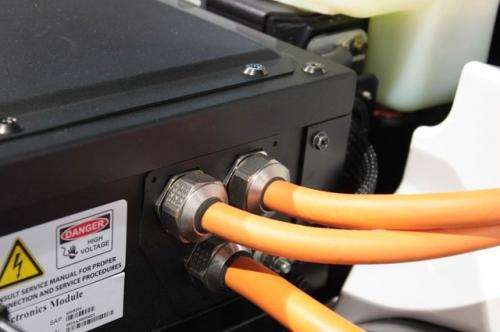Credit: Norio Nakayama/Creative Commons
California leaders are wringing their hands now that Tesla Motors has chosen Nevada as the site for its planned $5 billion "gigafactory." Lost to California is a battery superfactory with 6,500 on-site jobs, plus thousands more in supportive industries.
But California still has an opportunity to boost an entirely different battery supply market, one that will also help the state clean our energy supply and reduce the cost of electric vehicles in the process. The answer lies not in manufacturing new batteries, but repurposing used ones.
Most people are unaware that the expensive, high-capacity lithium ion batteries in plug-in electric vehicles still retain significant capacity once they are no longer useful in the vehicle. After eight or 10 years in your Nissan Leaf or Tesla Model S, your battery may not take you as far as you'd like on a single charge, prompting you to buy a new one.
But that old battery will likely have 70 to 80 percent capacity remaining. Stacks of these used, less expensive batteries could clean the electric grid by storing surplus wind and solar power for when the wind isn't blowing and the sun isn't shining. They could also provide power for homes and businesses during times of high demand, reducing the need for dirty "peaker" power plants. Plus, electric vehicles could be less expensive if automakers factor in the long-term resale value of the batteries in the sale price.
These batteries will have significant energy storage potential, as I document in a new study to be released Wednesday. More than 100,000 electric vehicles have already been sold in California alone, and the state aims for 1.5 million by 2025. Assuming 50 percent of the battery packs can be repurposed, with 75 percent of their original capacity, the "second-life" batteries on the road by 2025 could store and dispatch enough electricity to power 4.5 million households in any given moment, equivalent to almost 10 percent of the state's installed power capacity. And this potential will only increase as electric vehicles sales grow.
For electric vehicle owners, that resale value can translate into hard cash. Preliminary studies indicate, for example, that a used Nissan Leaf battery could net the vehicle owner as much as $2,000 in resale value, while bigger batteries, such as in the Tesla Model S, could sell for significantly more. For California, that means a whole new industry dedicated to repurposing and deploying the batteries, with attendant jobs and economic benefits.
So what will it take for California to harness this battery repurposing market? State leaders should:
- Aggressively support and partner with automakers, utilities and other private sector entities to develop more second-life battery demonstration projects to document the market potential for investors and the companies involved.
- Partner with industry leaders to identify and address the regulatory conflicts that limit market development, often unintentionally.
- And work with industry leaders and other interested parties to clarify product liability rules based on second-life battery performance standards, creating more certainty about who pays in the event of damages.
These initial steps will help ensure that the state doesn't lose out on the next big thing in the battery market. While Californians will eventually benefit from Tesla's success with the Nevada gigafactory, we shouldn't grow complacent about the possibilities here. The opportunities from repurposed batteries are simply too important for both our economic and environmental bottom line.
Provided by University of California, Los Angeles






















